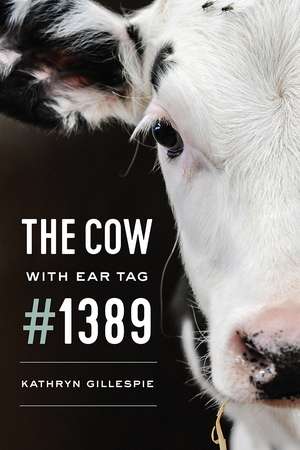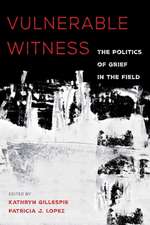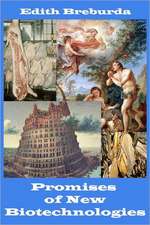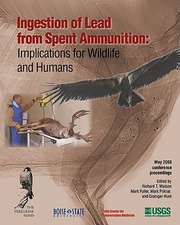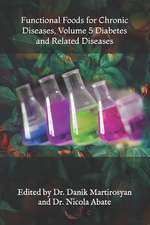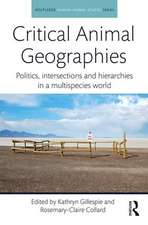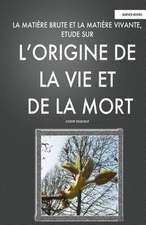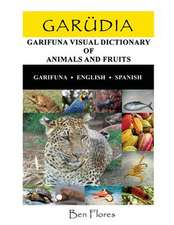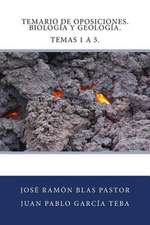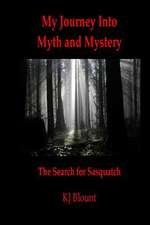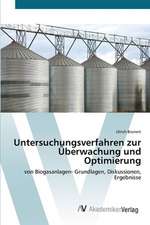The Cow with Ear Tag #1389
Autor Kathryn Gillespieen Limba Engleză Paperback – 29 noi 2018
To translate the journey from a living cow to a glass of milk into tangible terms, Kathryn Gillespie set out to follow the moments in the life cycles of individual animals—animals like the cow with ear tag #1389. She explores how the seemingly benign practice of raising animals for milk is just one link in a chain that affects livestock across the agricultural spectrum. Gillespie takes readers to farms, auction yards, slaughterhouses, and even rendering plants to show how living cows become food. The result is an empathetic look at cows and our relationship with them, one that makes both their lives and their suffering real.
Preț: 131.95 lei
Nou
Puncte Express: 198
Preț estimativ în valută:
25.25€ • 26.100$ • 21.05£
25.25€ • 26.100$ • 21.05£
Carte disponibilă
Livrare economică 28 martie-11 aprilie
Livrare express 13-19 martie pentru 23.94 lei
Preluare comenzi: 021 569.72.76
Specificații
ISBN-13: 9780226582856
ISBN-10: 022658285X
Pagini: 272
Ilustrații: 4 halftones, 5 line drawings
Dimensiuni: 152 x 229 x 13 mm
Greutate: 0.36 kg
Ediția:First Edition
Editura: University of Chicago Press
Colecția University of Chicago Press
ISBN-10: 022658285X
Pagini: 272
Ilustrații: 4 halftones, 5 line drawings
Dimensiuni: 152 x 229 x 13 mm
Greutate: 0.36 kg
Ediția:First Edition
Editura: University of Chicago Press
Colecția University of Chicago Press
Notă biografică
Kathryn Gillespie is coeditor of Critical Animal Geographies and Economies of Death.
Cuprins
One. Sadie
Two. The Politics of Research
Three. The Smell of Money
Four. Life for Sale
Five. The Cow with Ear Tag #1389
Six. Seeking Sanctuary
Seven. Doublethinking Dairy
Eight. “The Stamp of Dairyness”
Nine. California Dreaming
Ten. On Knowing and Responding
Acknowledgments
Notes
Index
Two. The Politics of Research
Three. The Smell of Money
Four. Life for Sale
Five. The Cow with Ear Tag #1389
Six. Seeking Sanctuary
Seven. Doublethinking Dairy
Eight. “The Stamp of Dairyness”
Nine. California Dreaming
Ten. On Knowing and Responding
Acknowledgments
Notes
Index
Recenzii
“Positioning her work among such investigative classics as Upton Sinclair’s The Jungle and Eric Schlosser’s Fast Food Nation, Gillespie uses scholarly methods to bring to light the often hidden side of what it takes to produce such foods as cheese and ice cream. . . .Interviews with dairy farmers and 4-H participants give fascinating insight into the emotional toll sometimes exacted on humans. . .Gillespie also vividly describes the deleterious effects of long-term dairy production on the animals themselves, as demonstrated by the titular cow. . .She succeeds in ensuring her readers will never look at a glass of milk in quite the same way again.”
“What price a glass of milk? In this trenchant examination of the dairy industry, animal-studies researcher Kathryn Gillespie investigates its workings, wastefulness, and impacts on the environment. . .Gillespie’s central focus, however, is the effect on the cows, bulls and calves involved, before their inevitable slaughter. Her careful field research in auction yards and slaughterhouses shows how commodification of animals too often leads to severe, and disturbing, health and welfare issues.”
“I'm equal parts haunted and motivated by The Cow with Ear Tag #1389. . .This hard-hitting book explores, with thoughtful-yet-unapologetic precision, the life cycle of individual animals—such as '#1389'—transporting rapt readers to auction yards and slaughterhouses, and paving the way for vital new inroads to discuss what it means to be truly empathetic.”
“How to help in a system that prizes profit over compassion is one of the main concerns in the book. . .We Americans have decided that some animals— .g., cats, dogs, hamsters, parrots—are companions and that others—e.g., cows, pigs, goats, lobsters—are dinner. We argue over the ethics of those choices, but Gillespie raises a more fundamental question: What do we owe any animal, including the ones from which we take milk? Her answer as implied in The Cow with Ear Tag #1389 is that we should not make them suffer.”
“Gillespie describes the cultural picture of dairy in the US by analyzing print and online resources from various points on dairy’s commodity chain: academic papers on animal agriculture, agricultural law, advertisements. These contextualize the book’s most immediately arresting passages . . .Gillespie also situates dairy against a backdrop of societal anxieties about domesticity, hygiene and safety. . .Her book draws from her discussions with dairy industry employees who did agree to speak to her but, at the same time, she is most keen to pay attention to animals’ biographies, arguing that these challenge capitalism’s depersonalizing logic.”
“Gillespie holds nothing back, taking readers through the nightmare of the industrial slaughter-industry with eloquent but unsparing prose. The particular cow in question survives to live untroubled on an animal sanctuary, but the book is harrowing about the millions and millions not so fortunate.”
“A brutally frank account of four years studying the US dairy industry, with a focus on the lives of the cows trapped in it from cradle to slaughterhouse.”
“Gillespie is not the first person to analyze animal agriculture, but she provides a honest and human element to the journey that I found deeply moving. . . . This book is a valuable addition to a growing canon of literature that challenges our understanding of “normal,” that will hopefully, as more people become aware of the horror, lead to positive changes for animals. . . . The Cow with Ear Tag #1389 is doing its part to open hearts and minds.”
“An incredibly instructive book that can be illuminating for people inside and outside the academy and should be introduced in animal studies courses across disciplines. Having a book one can turn to that overtly unveils the concealed aspects of the dairy industry is an invaluable resource for all those interested in furthering the cause of animal liberation.”
“There is much to be learned from Gillespie's book. . .She's remarkably sensitive to the ethical, methodological, and existential questions that come up when doing this kind of research. She explores the difficulty of getting approval for research on animals that we readily kill. She works through the many ways that commodification gets in the way of understanding animals. She reflects on the gendered expectations that affect her ability to gain access to her research subjects, as well as the way that they affect what she feels pressured to witness. And she is highly sensitive to the transformative dimensions of research, making some kind of lived response — in her case, dietary change — feel entirely necessary. . . . Gillespie does the reader a remarkable service in making herself visible in the text, letting us appreciate the way that her experience of doing this work shapes the work itself. It's rare to have such transparency, it's a model for anyone concerned to avoid the illusion that scholars are impartial spectators. The Cow with Ear Tag #1389 is worth reading for many reasons, but it's invaluable for this one.”
“The Cow with Ear Tag #1389 addresses a critical issue whose time for discussion has not only come but is in fact long overdue. Gillespie deftly excavates and narrates the singular moments of the dairy animals she encounters, and a very real story of the personalized cows emerges.”
“We have been waiting for a book like this. Gillespie grapples with how the dairy industry uses cows as well as the challenge of researching that very thing. Her writing is pitch perfect, richly detailed, and riveting. The Cow with Ear Tag #1389 vividly demonstrates the transformative power of scholarship to bear witness.”
“Simultaneously engaging, provocative, rigorous, and heartfelt, The Cow with Ear Tag #1389 demystifies the doublethink that dazes decent people into complicity with callous cruelty. Let Gillespie be your tour guide to the dairy farm, state fair, and petting zoo, and you might find yourself exploring the backroads of your own mind.”
“Gillespie’s stories and writing bring this book to life. We can feel the cows breathe and smell the grass as she unlocks the intricate relationship we have with these gentle animals. Her ability to explain complex issues in simple terms makes this an important read—especially for those who want to help foster compassion and understanding.”
“In a gripping narrative, Gillespie weaves together an informative discussion of the complexities of the dairy industry with heart-wrenching reflections on the impact of this commodification process on animals. She reveals alternative relationships of care that can help us look more closely, see better, and hopefully work toward changing ourselves and other animals.”
